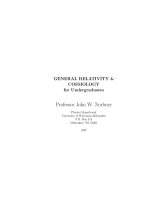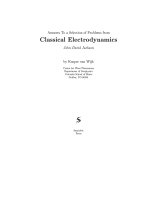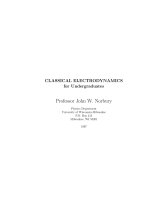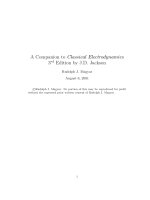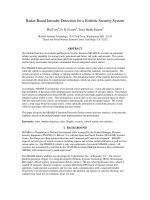- Trang chủ >>
- Khoa Học Tự Nhiên >>
- Vật lý
Classical electrodynamics for undergraduates - h norbury
Bạn đang xem bản rút gọn của tài liệu. Xem và tải ngay bản đầy đủ của tài liệu tại đây (690.61 KB, 113 trang )
CLASSICAL ELECTRODYNAMICS
for Undergraduates
Professor John W. Norbury
Physics Department
University of Wisconsin-Milwaukee
P.O. Box 413
Milwaukee, WI 53201
1997
Contents
1 MATRICES 5
1.1 Einstein Summation Convention 5
1.2 Coupled Equations and Matrices 6
1.3 Determinants and Inverse 8
1.4 Solution of Coupled Equations 11
1.5 Summary 11
1.6 Problems 13
1.7 Answers 14
1.8 Solutions 15
2 VECTORS 19
2.1 Basis Vectors 19
2.2 Scalar Product 20
2.3 Vector Product 22
2.4 Triple and Mixed Products 25
2.5 Div, Grad and Curl (differential calculus for vectors) 26
2.6 Integrals of Div, Grad and Curl 31
2.6.1 Fundamental Theorem of Gradients 32
2.6.2 Gauss’ theorem (Fundamental theorem of Divergence) 34
2.6.3 Stokes’ theorem (Fundamental theorem of curl) 35
2.7 Potential Theory 36
2.8 Curvilinear Coordinates 37
2.8.1 Plane Cartesian (Rectangular) Coordinates 37
2.8.2 Three dimensional Cartesian Coordinates 38
2.8.3 Plane (2-dimensional) Polar Coordinates 38
2.8.4 Spherical (3-dimensional) Polar Coordinates 40
2.8.5 Cylindrical (3-dimensional) Polar Coordinates 41
2.8.6 Div, Grad and Curl in Curvilinear Coordinates 43
1
2 CONTENTS
2.9 Summary 43
2.10 Problems 44
2.11 Answers 46
2.12 Solutions 47
2.13 Figure captions for chapter 2 51
3 MAXWELL’S EQUATIONS 53
3.1 Maxwell’s equations in differential form 54
3.2 Maxwell’s equations in integral form 56
3.3 Charge Conservation 57
3.4 Electromagnetic Waves 58
3.5 Scalar and Vector Potential 60
4 ELECTROSTATICS 63
4.1 Equations for electrostatics 63
4.2 Electric Field 66
4.3 Electric Scalar potential 68
4.4 Potential Energy 70
4.4.1 Arbitrariness of zero point of potential energy 74
4.4.2 Work done in assembling a system of charges 74
4.5 Multipole Expansion 76
5 Magnetostatics 77
5.1 Equation for Magnetostatics 77
5.1.1 Equations from Amp`er´e’sLaw 78
5.1.2 Equations from Gauss’ Law 78
5.2 Magnetic Field from the Biot-Savart Law 79
5.3 Magnetic Field from Amp`er´e’sLaw 81
5.4 Magnetic Field from Vector Potential 81
5.5 Units 81
6 ELECTRO- AND MAGNETOSTATICS IN MATTER 83
6.1 Units 83
6.2 Maxwell’s Equations in Matter 85
6.2.1 Electrostatics 85
6.2.2 Magnetostatics 86
6.2.3 Summary of Maxwell’s Equations 88
6.3 Further Dimennsional of Electrostatics 89
6.3.1 Dipoles in Electric Field 89
CONTENTS 3
6.3.2 Energy Stored in a Dielectric 90
6.3.3 Potential of a Polarized Dielectric 91
7 ELECTRODYNAMICS AND MAGNETODYNAMICS 93
7.0.4 Faradays’s Law of Induction 93
7.0.5 Analogy between Faraday field and Magnetostatics . . 96
7.1 Ohm’s Law and Electrostatic Force 97
8 MAGNETOSTATICS 101
9 ELECTRO- & MAGNETOSTATICS IN MATTER 103
10 ELECTRODYNAMICS AND MAGNETODYNAMICS 105
11 ELECTROMAGNETIC WAVES 107
12 SPECIAL RELATIVITY 109
4 CONTENTS
Chapter 1
MATRICES
1.1 Einstein Summation Convention
Even though we shall not study vectors until chapter 2, we will introduce
simple vectors now so that we can more easily understand the Einstein sum-
mation convention.
We are often used to writing vectors in terms of unit basis vectors as
A = A
x
ˆ
i + A
y
ˆ
j + A
z
ˆ
k. (1.1)
(see Figs. 2.7 and 2.8.) However we will find it much more convenient instead
to write this as
A = A
1
ˆe
1
+ A
2
ˆe
2
+ A
3
ˆe
3
(1.2)
where our components (A
x
,A
y
,A
z
) are re-written as (A
1
,A
2
,A
3
) and the
basis vectors (
ˆ
i,
ˆ
j,
ˆ
k) become (ˆe
1
, ˆe
2
, ˆe
3
). This is more natural when con-
sidering other dimensions. For instance in 2 dimensions we would write
A = A
1
ˆe
1
+ A
2
ˆe
2
and in 5 dimensions we would write A = A
1
ˆe
1
+ A
2
ˆe
2
+
A
3
ˆe
3
+ A
4
ˆe
4
+ A
5
ˆe
5
.
However, even this gets a little clumsy. For example in 10 dimensions we
would have to write out 10 terms. It is much easier to write
A =
N
i
A
i
ˆe
i
(1.3)
where N is the number of dimensions. Notice in this formula that the index
i occurs twice in the expression A
i
ˆe
i
. Einstein noticed this always occurred
and so whenever an index was repeated twice he simply didn’t bother to
5
6 CHAPTER 1. MATRICES
write
N
i
as well because he just knew it was always there for twice repeated
indices so that instead of writing A =
i
A
i
ˆe
i
he would simply write A =
A
i
ˆe
i
knowing that there was really a
i
in the formula, that he wasn’t
bothering to write explcitly. Thus the Einstein summation convention is
defined generally as
X
i
Y
i
≡
N
i
X
i
Y
i
(1.4)
Let us work out some examples.
————————————————————————————————–
Example 1.1.1 What is A
i
B
i
in 2 dimensions ?
Solution A
i
B
i
≡
2
i=1
A
i
B
i
= A
1
B
1
+ A
2
B
2
Example 1.1.2 What is A
ij
B
jk
in 3 dimensions ?
Solution We have 3 indices here (i, j, k), but only j is repeated
twice and so A
ij
B
jk
≡
3
j=1
A
ij
B
jk
= A
i1
B
1k
+A
i2
B
2k
+A
i3
B
3k
————————————————————————————————–
1.2 Coupled Equations and Matrices
Consider the two simultaneous (or coupled) equations
x + y =2
x − y = 0 (1.5)
which have the solutions x = 1 and y =1. Adifferent way of writing these
coupled equations is in terms of objects called matrices,
11
1 −1
x
y
=
x + y
x − y
=
2
0
(1.6)
Notice how the two matrices on the far left hand side get multiplied together.
The multiplication rule is perhaps clearer if we write
ab
cd
x
y
≡
ax + by
cx + dy
(1.7)
1.2. COUPLED EQUATIONS AND MATRICES 7
We have invented these matrices with their rule of ’multpilication’ simply as
a way of writing (1.5) in a fancy form. If we had 3 simultaneous equations
x + y + z =3
x − y + z =1
2x + z = 3 (1.8)
we would write
111
1 −11
201
x
y
z
=
x + y + z
x − y + z
2x +0y + z
=
4
2
4
(1.9)
Thus matrix notation is simply a way of writing down simultaneous equa-
tions. In the far left hand side of (1.6), (1.7) and (1.9) we have a square
matrix multiplying a column matrix. Equation (1.6) could also be written
as
[A][X]=[B] (1.10)
with
A
11
A
12
A
21
A
22
x
1
x
2
≡
A
11
x
1
+ A
12
x
2
A
21
x
2
+ A
22
x
2
≡
B
1
B
2
(1.11)
or B
1
= A
11
x
1
+ A
12
x
2
and B
2
= A
21
x
1
+ A
22
x
2
. A shorthand for this is
B
i
= A
ik
x
k
(1.12)
which is just a shorthand way of writing matrix multiplication form. Note
x
k
has 1 index and is a vector. Thus vectors are often written x = x
ˆ
i + y
ˆ
j
or just
x
y
. This is the matrix way of writing a vector. (do Problem
1.1)
Sometimes we want to multiply two square matrices together. The rule
for doing this is
A
11
A
12
A
21
A
22
B
11
B
12
B
21
B
22
≡
A
11
B
11
+ A
12
B
22
A
11
B
12
+ A
12
B
22
A
21
B
11
+ A
22
B
21
A
21
B
12
+ A
22
B
22
≡
C
11
C
12
C
21
C
22
(1.13)
8 CHAPTER 1. MATRICES
Thus, for example, C
11
= A
11
B
11
+ A
12
B
22
and C
21
= A
21
B
11
+ A
22
B
21
which can be written in shorthand as
C
ij
= A
ik
B
kj
(1.14)
which is the matrix multiplication formula for square matrices. This is very
easy to understand as it is just a generalization of (1.12) with an extra index
j tacked on. (do Problems 1.2 and 1.3)
————————————————————————————————–
Example 1.2.1 Show that equation (1.14) gives the correct form
for C
21
.
Solution C
ij
= A
ik
B
kj
.ThusC
21
= A
2k
B
k1
= A
21
B
11
+
A
22
B
21
.
Example 1.2.2 Show that C
ij
= A
ik
B
jk
is the wrong formula
for matrix multiplication.
Solution Let’s work it out for C
21
:
C
21
= A
2k
B
1k
= A
21
B
11
+A
22
B
12
. Comparing to the expressions
above we can see that the second term is wrong here.
————————————————————————————————–
1.3 Determinants and Inverse
We now need to discuss matrix determinant and matrix inverse. The deter-
minant for a 2 ×2 matrix is denoted
A
11
A
12
A
21
A
22
≡ A
11
A
22
− A
21
A
12
(1.15)
and for a 3 × 3 matrix it is
A
11
A
12
A
13
A
21
A
22
A
23
A
31
A
32
A
33
≡ A
11
A
22
A
33
+ A
12
A
23
A
31
+ A
13
A
21
A
32
−A
31
A
22
A
13
− A
21
A
12
A
33
− A
11
A
32
A
23
(1.16)
1.3. DETERMINANTS AND INVERSE 9
The identity matrix [I]is
10
01
for 2 × 2 matrices or
100
010
001
for
3 × 3 matrices etc. I is defined to have the true property of an identity,
namely
IB ≡ BI ≡ B (1.17)
where B is any matrix. Exercise: Check this is true by multuplying any
2 × 2 matrix times I.
The inverse of a matrix A is denoted as A
−1
and defined such that
AA
−1
= A
−1
A = I. (1.18)
The inverse is actually calculated using objects called cofactors [3]. Consider
the matrix A =
A
11
A
12
A
13
A
21
A
22
A
23
A
31
A
32
A
33
. The cofactor of the matrix element
A
21
for example is defined as
cof(A
21
) ≡ (−)
2+1
A
12
A
13
A
32
A
33
= −(A
12
A
33
− A
32
A
13
) (1.19)
The way to get the matrix elements appearing in this determinant is just by
crossing out the rows and columns in which A
21
appears in matrix A and
the elements left over go into the cofactor.
————————————————————————————————–
Example 1.3.1 What is the cofactor of A
22
?
Solution
cof(A
22
) ≡ (−)
2+2
A
11
A
13
A
31
A
33
= A
11
A
33
− A
31
A
13
————————————————————————————————–
Finally we get to the matrix inverse. The matrix elements of the inverse
matrix are given by [3]
(A
−1
)
ij
≡
1
|A|
cof(A
ji
)
10 CHAPTER 1. MATRICES
(1.20)
Notice that the ij matrix element of the inverse is given by the ji cofactor.
————————————————————————————————–
Example 1.3.2 Find the inverse of
11
1 −1
and check your
answer.
Solution Let’s write A =
A
11
A
12
A
21
A
22
=
11
1 −1
.
Now cof(A
11
) ≡ (−)
1+1
|A
22
| = A
22
= −1. Notice that the
determinant in the cofactor is just a single number for 2 × 2
matrices. The other cofactors are
cof(A
12
) ≡ (−)
1+2
|A
21
| = −A
21
= −1
cof(A
21
) ≡ (−)
2+1
|A
12
| = −A
12
= −1
cof(A
22
) ≡ (−)
2+2
|A
11
| = A
11
=1.
The determinant of A is |A| = A
11
A
22
−A
21
A
12
= −1 −1=−2.
Thus from (1.20)
(A
−1
)
11
≡
1
−2
cof(A
11
)=
1
2
,
(A
−1
)
12
≡
1
−2
cof(A
21
)=
1
2
,
(A
−1
)
21
≡
1
−2
cof(A
12
)=
1
2
,
(A
−1
)
22
≡
1
−2
cof(A
22
)=−
1
2
.
Thus A
−1
=
1
2
11
1 −1
.
We can check our answer by making sure that AA
−1
= I as
follows,
AA
−1
=
11
1 −1
1
2
11
1 −1
=
1
2
11
1 −1
11
1 −1
=
1
2
20
02
=
10
01
.
Thus we are now sure that our calculation of A
−1
is correct.
Also having verified this gives justification for believing in all the
formulas for cofactors and inverse given above. (do Problems
1.4 and 1.5)
————————————————————————————————–
1.4. SOLUTION OF COUPLED EQUATIONS 11
1.4 Solution of Coupled Equations
By now we have developed quite a few skills with matrices, but what is the
point of it all ? Well it allows us to solve simultaneous (coupled) equations
(such as (1.5)) with matrix methods. Writing (1.6)) as AX = Y where
A =
11
1 −1
,X =
x
y
,Y =
2
0
, we see that the solution we
want is the value for x and y. In other words we want to find the column
matrix X. We have
AX = Y (1.21)
so that
A
−1
AX = A
−1
Y. (1.22)
Thus
X = A
−1
Y (1.23)
where we have used (1.18).
————————————————————————————————–
Example 1.4.1 Solve the set of coupled equations (1.5) with
matrix methods.
Solution Equation (1.5) is re-written in (1.6) as AX = Y with
A =
11
1 −1
,X =
x
y
,Y =
2
0
. We want X =
A
−1
Y . From Example 1.3.2 we have A
−1
=
1
2
11
1 −1
.Thus
X = A
−1
Y means
x
y
=
1
2
11
1 −1
2
0
=
1
2
2
2
=
1
1
.
Thus x = 1 and y =1.
————————————————————————————————–
1.5 Summary
This concludes our discussion of matrices. Just to summarize a little, firstly
it is more than reasonable to simply think of matrices as another way of
writing and solving simultaneous equations. Secondly, our invention of how
to multiply matrices in (1.12) was invented only so that it reproduces the
12 CHAPTER 1. MATRICES
coupled equations (1.5). For multiplying two square matrices equation (1.14)
is just (1.12) with another index tacked on. Thirdly, even though we did not
prove mathematically that the inverse is given by (1.20), nevertheless we can
believe in the formula becasue we always found that using it gives AA
−1
= I.
It doesn’t matter how you get A
−1
, as long as AA
−1
= I you know that you
have found the right answer. A proof of (1.20) can be found in mathematics
books [3, 4].
1.6. PROBLEMS 13
1.6 Problems
1.1 Show that B
i
= A
ik
x
k
gives (1.11).
1.2 Show that C
ij
= A
ik
B
kj
gives (1.13).
1.3 Show that matrix multiplication is non-commutative, i.e. AB = BA.
1.4 Find the inverse of
11
01
and check your answer.
1.5 Find the inverse of
111
1 −11
201
and check your answer.
1.6 Solve the following simultaneous equations with matrix methods:
x + y + z =4
x − y + z =2
2x + z =4
14 CHAPTER 1. MATRICES
1.7 Answers
1.4
1 −1
01
1.5
−
1
2
−
1
2
1
1
2
−
1
2
0
11−1
1.6 x =1,y =1,z =2.
1.8. SOLUTIONS 15
1.8 Solutions
1.1
B
i
= A
ik
x
k
. We simply evaluate each term. Thus
B
1
= A
1k
x
k
= A
11
x
1
+ A
12
x
2
B
2
= A
2k
x
k
= A
21
x
1
+ A
22
x
2
.
1.2
C
ij
= A
ik
B
kj
. Again just evaluate each term. Thus
C
11
= A
1k
B
k1
= A
11
B
11
+ A
12
B
21
C
12
= A
1k
B
k2
= A
11
B
12
+ A
12
B
22
C
21
= A
2k
B
k1
= A
21
B
11
+ A
22
B
21
C
22
= A
2k
B
k2
= A
21
B
12
+ A
22
B
22
.
1.3
This can be seen by just multiplying any two matrices, say
12
34
56
78
=
19 22
33 50
.
Whereas
56
78
12
34
=
23 34
31 46
.
showing that matrix multiplication does not commute.
16 CHAPTER 1. MATRICES
1.4
Let’s write A =
A
11
A
12
A
21
A
22
=
11
01
.Nowcof(A
11
) ≡
(−)
1+1
|A
22
| = A
22
= 1. Notice that the determinant in the
cofactor is just a single number for 2 × 2 matrices. The other
cofactors are
cof(A
12
) ≡ (−)
1+2
|A
21
| = −A
21
=0
cof(A
21
) ≡ (−)
2+1
|A
12
| = −A
12
= −1
cof(A
22
) ≡ (−)
2+2
|A
11
| = A
11
=1.
The determinant of A is |A| = A
11
A
22
−A
21
A
12
= 1. Thus from
(1.20)
(A
−1
)
11
≡
1
1
cof(A
11
)=1,
(A
−1
)
12
≡
1
1
cof(A
21
)=−1,
(A
−1
)
21
≡
1
1
cof(A
12
)=0,
(A
−1
)
22
≡
1
1
cof(A
22
)=1.
Thus A
−1
=
1 −1
01
.
We can check our answer by making sure that AA
−1
= I as
follows,
AA
−1
=
11
01
1 −1
01
=
10
01
= I. Thusweare
now sure that our answer for A
−1
is correct.
1.8. SOLUTIONS 17
1.5
Let’s write A =
A
11
A
12
A
13
A
21
A
22
A
23
A
31
A
32
A
33
=
111
1 −11
201
.
The cofactors are
cof(A
11
)=(−)
1+1
A
22
A
23
A
32
A
33
=+(A
22
A
33
− A
32
A
23
)=−1 − 0=−1
cof(A
12
)=(−)
1+2
A
21
A
23
A
31
A
33
= −(A
21
A
33
− A
31
A
23
)=−1+2=1
cof(A
13
)=(−)
1+3
A
21
A
22
A
31
A
32
=+(A
21
A
32
− A
31
A
22
)=0+2=2
cof(A
21
)=(−)
2+1
A
12
A
13
A
32
A
33
= −(A
12
A
33
− A
32
A
13
)=−1+0=−1
cof(A
22
)=(−)
2+2
A
11
A
13
A
31
A
33
=+(A
11
A
33
− A
31
A
13
)=1−2=−1
cof(A
23
)=(−)
2+3
A
11
A
12
A
31
A
32
= −(A
11
A
32
− A
31
A
12
)=−0+2=2
cof(A
31
)=(−)
3+1
A
12
A
13
A
22
A
23
=+(A
12
A
23
− A
22
A
13
)=1+1=2
cof(A
32
)=(−)
3+2
A
11
A
13
A
21
A
23
= −(A
11
A
23
− A
21
A
13
)=−1+1=0
cof(A
33
)=(−)
3+3
A
11
A
12
A
21
A
22
=+(A
11
A
22
− A
21
A
12
)=−1 − 1=−2
The determinant of A is (see equation (1.16)) |A| = 2. Thus from (1.20)
(A
−1
)
11
≡
1
2
cof(A
11
)=−
1
2
,
(A
−1
)
12
≡
1
2
cof(A
21
)=−
1
2
,
(A
−1
)
13
≡
1
2
cof(A
31
)=1,
18 CHAPTER 1. MATRICES
(A
−1
)
21
≡
1
2
cof(A
12
)=
1
2
,
(A
−1
)
22
≡
1
2
cof(A
22
)=−
1
2
.
(A
−1
)
23
≡
1
2
cof(A
32
)=0,
(A
−1
)
31
≡
1
2
cof(A
13
)=1,
(A
−1
)
32
≡
1
2
cof(A
23
)=1.
(A
−1
)
33
≡
1
2
cof(A
33
)=−1,
Thus A
−1
=
−
1
2
−
1
2
1
1
2
−
1
2
0
11−1
.
We can check our answer by making sure that AA
−1
= I as follows,
AA
−1
=
111
1 −11
201
−
1
2
−
1
2
1
1
2
−
1
2
0
11−1
=
100
010
001
= I.Thus
we are now sure that our answer for A
−1
is correct.
1.6
AX = Y is written as
111
1 −11
201
x
y
z
=
4
2
4
Thus X = A
−1
Y and we found A
−1
in problem 1.5.
Thus
x
y
z
=
−
1
2
−
1
2
1
1
2
−
1
2
0
11−1
4
2
4
=
1
1
2
.
Thus the solution is x =1,y =1,z =2.
Chapter 2
VECTORS
In this review chapter we shall assume some familiarity with vectors from
fresman physics. Extra details can be found in the references [1].
2.1 Basis Vectors
We shall assume that we can always write a vector in terms of a set of basis
vectors
A = A
x
ˆ
i + A
y
ˆ
j + A
z
ˆ
k = A
1
ˆe
1
+ A
2
ˆe
2
+ A
3
ˆe
3
= A
i
ˆe
i
(2.1)
where the components of the vector A are (A
x
,A
y
,A
z
)or(A
1
,A
2
,A
3
) and
the basis vectors are (
ˆ
i,
ˆ
j,
ˆ
k)or(ˆe
1
, ˆe
2
, ˆe
3
). The index notation A
i
and ˆe
i
is
preferrred because it is easy to handle any number of dimensions.
In equation (2.1) we are using the Einstein summation convention for
repeated indices which says that
x
i
y
i
≡
i
x
i
y
i
. (2.2)
In other words when indices are repeated it means that a sum is always
implied. We shall use this convention throughout this book.
With basis vectors it is always easy to add and subtract vectors
A + B = A
i
ˆe
i
+ B
i
ˆe
i
=(A
i
+ B
i
)ˆe
i
. (2.3)
Thus the components of A + B are obtained by adding the components of
A and B separately. Similarly, for example,
A − 2B = A
i
ˆe
i
− 2B
i
ˆe
i
=(A
i
− 2B
i
)ˆe
i
. (2.4)
19
20 CHAPTER 2. VECTORS
2.2 Scalar Product
Let us define the scalar product (also often called the inner product) of two
vectors as
A.B ≡ AB cos θ
(2.5)
where A ≡|A| is the magnitude of A and θ is the angle between A and B.
(Here || means magnitude and not deteminant). Thus
A.B = A
i
ˆe
i
.B
j
ˆe
j
(2.6)
Note that when we are multiplying two quantities that both use the Einstein
summation convention, we must use different indices. (We were OK before
when adding). To see this let’s work out (2.6) explicitly in two dimensions.
A = A
1
ˆe
1
+A
2
ˆe
2
and B = B
1
ˆe
1
+B
2
ˆe
2
so that A.B =(A
1
ˆe
1
+A
2
ˆe
2
).(B
1
ˆe
1
+
B
2
ˆe
2
)=A
1
B
1
ˆe
1
.ˆe
1
+ A
1
B
2
ˆe
1
.ˆe
2
+ A
2
B
1
ˆe
2
.ˆe
1
+ A
2
B
2
ˆe
2
.ˆe
2
which is exactly
what you get when expanding out (2.6). However if we had mistakenly
written A.B = A
i
ˆe
i
.B
i
ˆe
i
= A
i
B
i
ˆe
i
.ˆe
i
= A
1
B
1
ˆe
1
.ˆe
1
+ A
2
B
2
ˆe
2
.ˆe
2
which is
wrong. A basic rule of thumb is that it’s OK to have double repeated indices
but it’s never OK to have more.
Let’s return to our scalar product
A.B = A
i
ˆe
i
.B
j
ˆe
j
=(ˆe
i
.ˆe
j
)A
i
B
j
≡ g
ij
A
i
B
j
(2.7)
where we define a quantitiy g
ij
called the metric tensor as g
ij
≡ ˆe
i
.ˆe
j
. Note
that vector components A
i
have one index, scalars never have any indices
and matrix elements have two indices A
ij
. Thus scalars are called tensors
of rank zero, vectors are called tensors of rank one and some matrices are
tensors of rank two. Not all matrices are tensors because they must also
satisfy the tensor transformation rules [1] which we will not go into here.
However all tensors of rank two can be written as matrices. There are also
tensors of rank three A
ijk
etc. Tensors of rank three are called tensors of
rank three. They do not have a special name like scalar and vector. The
same is true for tensors of rank higher than three.
2.2. SCALAR PRODUCT 21
Now if we choose our basis vectors ˆe
i
to be of unit length |ˆe
i
| = 1 and
orthogonal to each other then by (2.5)
ˆe
i
.ˆe
j
= |ˆe
i
||ˆe
j
|cos θ = cos θ = δ
ij
(2.8)
where δ
ij
is defined as
δ
ij
≡ 1 if i = j
≡ 0 if i = j (2.9)
which can also be written as a matrix
[δ
ij
]=
10
01
(2.10)
for two dimensions. Thus if g
ij
= δ
ij
then we have what is called a Cartesian
space (or flat space), so that
A.B = g
ij
A
i
B
j
= δ
ij
A
i
B
j
= δ
i1
A
i
B
1
+ δ
i2
A
i
B
2
= δ
11
A
1
B
1
+ δ
21
A
2
B
1
+ δ
12
A
1
B
2
+ δ
22
A
2
B
2
= A
1
B
1
+ A
2
B
2
≡ A
i
B
i
. (2.11)
Thus
A.B = A
i
B
i
(2.12)
Now A.B = A
i
B
i
= A
x
B
x
+ A
y
B
y
is just the scalar product that we are
used to from freshman physics, and so Pythagoras’ theorem follows as
A.A ≡ A
2
= A
i
A
i
= A
2
x
+ A
2
y
. (2.13)
Note that the fundamental relations of the scalar product (2.12) and the
form of Pythagoras’ theorem follow directly from our specification of the
metric tensor as g
ij
= δ
ij
=
10
01
.
As an aside, note that we could easily have defined a non-Cartesian
space, for example g
ij
=
11
01
in which case Pythagoras’ theorem would
change to
A.A ≡ A
2
= A
i
A
i
= A
2
x
+ A
2
y
+ A
x
A
y
. (2.14)
22 CHAPTER 2. VECTORS
Thus it is the metric tensor g
ij
≡ ˆe
i
.ˆe
j
given by the scalar product of the
unit vectors which (almost) completely defines the vector space that we are
considering.
2.3 Vector Product
In the previous section we ’multiplied’ two vectors to get a scalar A.B.How-
ever if we start with two vectors maybe we can also define a ’multiplication’
that results in a vector, which is our only other choice. This is called the
vector product or cross product denoted as A × B. The magnitude of the
vector product is defined as
|A × B|≡AB sin θ (2.15)
whereas the direction of C = A × B is defined as being given by the right
hand rule, whereby you hold the thumb, fore-finger and middle finger of your
right hand all at right angles to each other. The thumb represents vector C,
the fore-finger represents A and the middle finger represents B.
————————————————————————————————–
Example 2.3.1 If D is a vector pointing to the right of the page
and E points down the page, what is the direction of D ×E and
E × D?
Solution D is the fore-finger, E is the middle finger and so
D ×E which is represented by the thumb ends up pointing into
the page. For E×D we swap fingers and the thumb E×D points
out of the page. (do Problem 2.1)
————————————————————————————————–
From our definitions above for the magnitude and direction of the vector
product it follows that
ˆe
1
× ˆe
1
=ˆe
2
× ˆe
2
=ˆe
3
× ˆe
3
= 0 (2.16)
because θ =0
o
for these cases. Also
ˆe
1
× ˆe
2
=ˆe
3
= −ˆe
2
× ˆe
1
ˆe
2
× ˆe
3
=ˆe
1
= −ˆe
3
× ˆe
2
ˆe
3
× ˆe
1
=ˆe
2
= −ˆe
1
× ˆe
3
(2.17)
2.3. VECTOR PRODUCT 23
which follows from the right hand rule and also because θ =90
o
.
Let us now introduce some short hand notation in the form of the Levi-
Civit´a symbol (not a tensor ??) defined as
ijk
≡ +1 if ijk are in the order of 123 (even permutation)
≡−1 if ijk not in the order of 123 (odd permutation)
≡ 0 if any of ijk are repeated (not a permutation)(2.18)
For example
123
= +1 because 123 are in order. Also
231
= +1 because
the numbers are still in order whereas
312
= −1 becasue 312 are out of
numerical sequence.
122
=
233
= 0 etc., because the numberse are not
a permutation of 123 because two numbers are repeated. Also note that
ijk
=
jki
=
kij
= −
ikj
etc. That is we can permute the indices without
changing the answer, but we get a minus sign if we only swap the places of
two indices. (do Problem 2.2)
We can now write down the vector product of our basis vectors as
ˆe
i
× ˆe
j
=
ijk
ˆe
k
(2.19)
where a sum over k is implied because it is a repeated index.
————————————————————————————————–
Example 2.3.2 Using (2.19) show that ˆe
2
׈e
3
=ˆe
1
and ˆe
2
׈e
1
=
−ˆe
3
and ˆe
1
× ˆe
1
=0.
Solution From (2.19) we have
ˆe
2
× ˆe
3
=
23k
ˆe
k
=
231
ˆe
1
+
232
ˆe
2
+
233
ˆe
3
=+1ˆe
1
+0ˆe
2
+0ˆe
3
=ˆe
1
.
ˆe
2
× ˆe
1
=
21k
ˆe
k
=
211
ˆe
1
+
212
ˆe
2
+
213
ˆe
3
=0ˆe
1
+0ˆe
2
− 1ˆe
3
= −ˆe
3
.
ˆe
1
× ˆe
1
=
11k
ˆe
k
=0.
because
11k
= 0 no matter what the value of k.
24 CHAPTER 2. VECTORS
————————————————————————————————–
Using (2.19) we can now write the vector product as A × B = A
i
ˆe
i
×
B
j
ˆe
j
= A
i
B
j
ˆe
i
× ˆe
j
= A
i
B
j
ijk
ˆe
k
Thus our general formula for the vector
product is
A × B =
ijk
A
i
B
j
ˆe
k
(2.20)
The advantage of this formula is that it gives both the magnitude and direc-
tion. Note that the kth component of A × B is just the coefficient in front
of ˆe
k
, i.e.
(A × B)
k
=
ijk
A
i
B
j
(2.21)
————————————————————————————————–
Example 2.3.3 Evaluate the x component of (2.20) explicitly.
Solution The right hand side of (2.20) has 3 sets of twice re-
peated indices ijk which implies
i
j
k
. Let’s do
k
first.
A×B =
ij1
A
i
B
j
ˆe
1
+
ij2
A
i
B
j
ˆe
2
+
ij3
A
i
B
j
ˆe
3
. The x component
of A × B is just the coefficient in front of ˆe
1
. Let’s do the sum
over i first. Thus
(A × B)
1
=
ij1
A
i
B
j
=
1j1
A
1
B
j
+
2j1
A
2
B
j
+
3j1
A
3
B
j
+
=
111
A
1
B
1
+
121
A
1
B
2
+
131
A
1
B
3
+
211
A
2
B
1
+
221
A
2
B
2
+
231
A
2
B
3
+
311
A
3
B
1
+
321
A
3
B
2
+
331
A
3
B
3
=0A
1
B
1
+0A
1
B
2
+0A
1
B
3
+
0A
2
B
1
+0A
2
B
2
+1A
2
B
3
+
0A
3
B
1
− 1A
3
B
2
+0A
3
B
3
= A
2
B
3
− A
3
B
2
.
————————————————————————————————–

